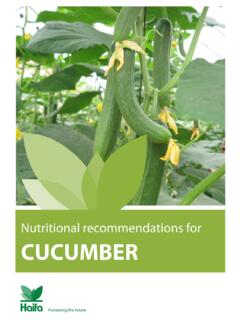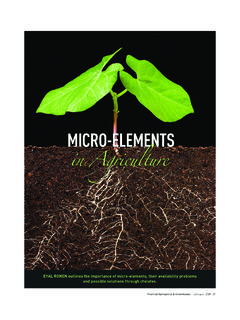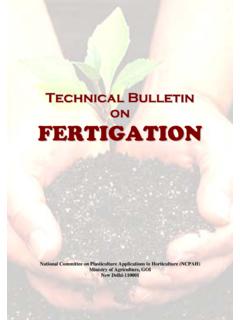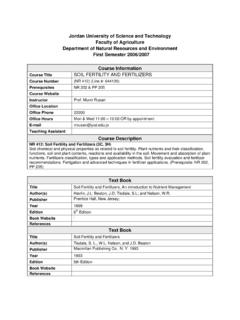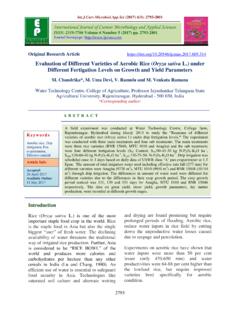Transcription of Nutritional recommendations for - Haifa-Group
1 1. Nutritional recommendations for OLIVES. Contents: 1. General 4. Origin and 4. Nutritional and health values of the olive fruit .. 5. Plant description and physiology .. 6. Dynamics of production and consumption of table olives .. 9. Olive 9. Olive cultivars .. 10. Yields .. 13. 2. Growing olives .. 14. Climate .. 14. Soil type .. 15. Propagation .. 15. Tree spacing .. 16. Planting design for cross pollination .. 17. Pruning .. 17. Alternate bearing and means to reduce its impact .. 19. Fruit thinning .. 20. 20. Fertilization .. 25. Harvesting and curing .. 26. 3. The mineral nutrition of olive trees .. 29. Summary of main plant nutrient functions .. 29. The three tools for optimal nutrient management .. 29. Seasonal nutrient requirements of olive trees .. 32. Main plant nutrients, their rates in olive leaves, deficiency symptoms and application rates and methods.
2 33. 4. Fertilization practices .. 49. Soil amelioration .. 49. Fertilization as a means to assure high soil fertility .. 50. Nutrient uptake / removal .. 50. Soil and leaf analysis .. 51. Application of fertilizers .. 52. N 52. N-P-K application .. 53. Soil application for rain-fed bearing orchards .. 53. The effect of irrigation on fruit yield and fertilizer application .. 55. The effect of fertigation on fruit yield and fertilizer application .. 55. Fertilization by means of foliar feeding .. 56. 2. 5. Haifa's recommendations for comprehensive mineral nutrition of olive orchards .. 63. Pre-planting soil amelioration .. 63. Pre-planting base dressing + side dressing .. 64. Pre-planting base dressing + irrigation & fertigation .. 64. No base dressing, but nutrition can be done by fertigation or side dressing programs from planting to fruit-bearing.
3 65. recommendations for an extensively cultivated, rain-fed, olive-bearing orchard yielding up to 10 ton / ha (25 kg / tree) .. 65. recommendations for a rain-fed, olive-bearing orchard yielding from 6 to 20 ton / ha (25 kg / tree) .. 66. recommendations for irrigated but not fertigated, olive-bearing orchard, yielding 3-5 ton / ha .. 66. recommendations for nutrigated (fertigated) olive-bearing orchard .. 67. Foliar feeding with Haifa 70. OliveDrop for enhanced mechanical harvesting .. 73. Nutrigation (fertigation) .. 74. Soil application - controlled-release nutrition .. 75. Haifa NutriNet - online fertilization and Nutrigation programs .. 75. Appendix I: Haifa specialty fertilizers .. 80. Pioneering solutions .. 80. Potassium nitrate .. 80. Multi-K products .. 80. Nutrigation .. 81. Foliar feeding .. 81. Controlled-release nutrition .. 82. Multicote products.
4 82. Appendix II: Conversion tables .. 83. 3. 1. General information Scientific name: Olea europaea L. Family: Oleaceae Related species: Wild Olive (Olea africana), Oleaster (O. europaea var. oleaster). Distant affinity: American Olive (Osmanthus americana), Fragrant Olive (O. fragrans). Common names: English: Olive. French: Olivier; Spanish: Olivo; Italian: Olivo;. German: Olive; Arabic: Zeitoun Origin and history Olive cultivation dates back more than 6,000 years and it is still flourishing today, not only in its countries of origin, but now in most areas of the world. The olive is native to the Mediterranean region, tropical and central Asia and various parts of Africa. The olive has a history almost as long as that of Western civilization, its development being one of civilized man's first accomplishments. At a site in Spain, carbon-dating has shown olive seed found there to be 8,000 years old.
5 The cultivation of O. europaea may have been initiated independently in both Crete and Syria. Archeological evidence suggests that olives were grown in Crete as long ago as 2,500. From Crete and Syria olives spread to Greece, Italy and other parts of the Mediterranean area. The leafy branches of the olive tree have been used for thousands of years as a symbol of abundance, glory and peace, such as to crown the victors of friendly games and bloody wars. As emblems of benediction and purification, they were also ritually offered to deities and powerful figures; some were even found in Tutankhamen's tomb. Over the years, the olive has been the symbol of peace, wisdom, glory, fertility, power and pureness. The olive tree and olives are mentioned over 30 times in both the New and Old Testaments of the Bible. It is one of the first plants mentioned in the Bible, and one of the most significant.
6 For example, it was an olive leaf that the dove brought back to Noah to demonstrate that the flood was over. An olive tree in Algarve, Portugal, is 2,000 years old, according to radiocarbon dating. The age of an olive tree in Crete, claimed to be over 2,000 years old, has been confirmed on the basis of tree ring analysis. According to a recent scientific survey, there are dozens of ancient olive trees throughout Israel and Biblical Palestine, 1,600-2,000 years old. Ancient trees include two giant olive trees in Arraba and five trees in Deir Hanna (both in the Galilee region), which have been determined to be over 3,000 years old, although the credibility of the study that produced these dates has been questioned. All seven trees still bear olives. 4. Nutritional and health values of the olive fruit The Nutritional value of the olive stems from the fact that it has very little carbohydrate and is a great source of monounsaturates.
7 This makes it a good element in a low-carbohydrate diet. There are many different types of olives and the broad categories are the green olives and the ripe black olives. Olives are a rich source of polyphenols, which are critical as our body's defense against cancer. Polyphenols have many good properties, and these elements, which are the reason for the taste and the smell of the olive, can also help as an anti-inflammatory. Olive oil Olive oil, which is extracted by pressing olives, is also a good source of many beneficial nutrients and minerals. The oil is a good source of antioxidants and, as a special bonus, it greatly adds to the flavor of dishes. As it contains monounsaturated fat, it does not elevate the level of cholesterol in the body. It is said that olive oil prevents the adherence of cholesterol to the walls of the artery. Additionally, monounsaturated fats also help in controlling blood sugar.
8 This affects the insulin regulation in the body in a positive way. In terms of their phytonutrient content, olives are nothing short of astounding. Few high-fat foods offer such a diverse range of antioxidant and anti-inflammatory nutrients, some of which are unique to olives. The following list specifies only the most important phytonutrient categories: Simple Phenols; Terpenes; Flavones; Hydroxycinnamic acids; Anthocyanidins;. Flavonols; Hydroxybenzoic acids and Hydroxyphenylacetic acids. According to the USDA, a single serving of 10 medium-sized green olives contains the following: Table : The nutritive value of 10 medium-sized green olives Energy 49 kcal Vitamin A 7 mcg Protein g Vitamin B1 mg Fat, total g Vitamin B6 g Carbohydrates g Niacin (Vitamin B3) mg Dietary fiber g Vitamin E mg Saturated fatty acids, total g Lutein + zeaxanthin 173 mcg Monounsaturated fatty acids, g Choline, total mg total Polyunsaturated fatty acids, total g Folate 1 mcg Calcium 18 mg Beta-carotene 79 mcg Magnesium 4 mg Iron mg Potassium 14 mg Sodium 529 mg Phosphorous 1 mg Zinc mg Copper mg Selenium mcg 5.
9 Plant description and physiology The olive tree is an evergreen tree or shrub, short and thick, and rarely exceeds 8 15 meters in height. Olives are long- lived with a life expectancy of 500 years. The trees are also persistent, easily sprouting back even when chopped to the ground. The trunk is typically crooked and twisted. The bark of the tree is pale gray. It has many thin branches with opposite branchlets. The leaves are opposite each other and are feather-shaped or elliptic, measuring 4 10 cm long and 1 3 cm wide. They are smooth and pale green on top and silvery on the bottom and their skin is rich in tannin, which gives the mature leaf a grayish-green hue. The leaves are replaced every two to three years, leaf-fall usually occurring at the same time that new growth appears in the spring. Flowers Olive trees produce two different types of creamy white flowers, a perfect flower, which contains both male and female parts, and a staminate flower with stamens only.
10 The small white, feathery flowers, with ten-cleft calyx and corolla, two stamens and bifid stigma, are borne generally on the last year's branches, in racemes springing from the leave's axils. The flowers are largely wind pollinated with most olive varieties being self-pollinating, although fruit-set is usually improved by cross pollination with other varieties. There are self- incompatible varieties that do not set fruit without other varieties nearby, and there are varieties that are incompatible with certain others. Incompatibility can also occur for environmental reasons such as high temperatures. Flower induction and fruit-set The tree is mature enough to produce flowers and fruits at the age of about four years. Changes affecting fruit-set start in the preceding summer. Absence of water stresses during preceding summer assists the change from vegetative buds into flower buds.



